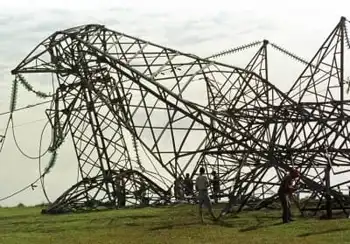Dworshak Dam given 'potentially unsafe' rating
Corps officials completed a risk assessment of the dam last February and rated Dworshak a 2 on a scale of 1 to 5, with 5 being the safest. Water is squeezing through flex joints, known as water stops, on the front of the dam.
In addition, many of the drains used to monitor water slipping beneath the foot of the dam are clogged and need to be cleaned so potentially dangerous uplift pressures can be monitored.
Still, Dworshak operations manager Greg Parker told the Lewiston Tribune the dam's 51 concrete monoliths remain robust and pose no danger of catastrophic failure — an event that would have dire consequences for residents living downstream in communities including Spalding, Lapwai and Lewiston in north-central Idaho.
"It's as safe now as when it was built," Parker said.
Even so, members of a team that rated Dworshak earlier this year mulled giving it a '1,' the lowest rating on the scale. That would have meant the dam would not be able to operate at full pool.
Bob Hollenbeck, chief of structural design for the Corps' Walla Walla district, said the rating of 2 was finally meted out because those scrutinizing the dam determined the uplift pressures were not out of line with Dworshak's design criteria.
"I believe it's a very appropriate rating," Hollenbeck said. "We need to be cognizant of everything that is downstream of us."
As much as anything, the safety rating is a reminder to officials that shortcomings at the structure erected during the last wave of Western dam building need to be addressed.
Named after Idaho U.S. Sen. Henry Dworshak, it was completed in 1972 and can generate enough electricity to light about 280,000 homes.
An emergency action plan — if the dam were to fail — is more than 25 years old and is in the process of being updated.
And other programs used to assess Dworshak's safety also await completion. There is tentatively $1 million in the 2009 federal budget to continue the work Corps officials say is needed. The money would pay for things like uplift drain cleaning and coming up with a way to stop the leaking.
Jim Milligan, a retired University of Idaho professor of civil engineering, recently toured the dam and talked to Parker and others about its safety assessment, leakage problems and what is being done to address them. Milligan said he was satisfied that Dworshak is in capable hands.
"My overall impression is the dam seems to be more carefully attended to than many I have visited in the past," he said. "The issues that have arisen there are not unexpected or out of the ordinary. They are fairly typical."
Related News

Imported coal volumes up 17% during Apr-Oct as domestic supplies shrink
WASHINGTON - The receipt of imported coal by thermal power plants has shot up by 17.6 per cent during April-October. The coal import volumes refer to the power plants monitored by the Central Electricity Authority (CEA), a power update report from CARE Ratings showed.
Imports escalated as domestic supplies by Coal India Ltd (CIL) and another state run producer- Singareni Collieries Company Ltd (SCCL) dipped in the period. Rate of supplies by the two coal companies to the CEA monitored power stations stood at 80.4 per cent, indicating a shortfall of 19.6 per cent against the allocated quantity.
According to the study…





